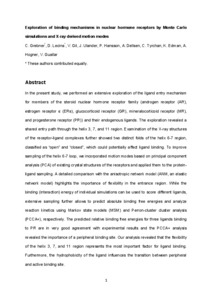Mostra el registre d'ítem simple
Exploring Binding Mechanisms in Nuclear Hormone Receptors by Monte Carlo and X-ray-derived Motions
| dc.contributor.author | Grebner, Christoph |
| dc.contributor.author | Lecina, Daniel |
| dc.contributor.author | Gil, Victor |
| dc.contributor.author | Ulander, Johan |
| dc.contributor.author | Hansson, Pia |
| dc.contributor.author | Dellsen, Anita |
| dc.contributor.author | Tyrchan, Christian |
| dc.contributor.author | Edman, Karl |
| dc.contributor.author | Hogner, Anders |
| dc.contributor.author | Guallar, Victor |
| dc.contributor.other | Barcelona Supercomputing Center |
| dc.date.accessioned | 2017-04-03T14:35:23Z |
| dc.date.available | 2018-04-03T00:30:20Z |
| dc.date.issued | 2017-03-28 |
| dc.identifier.citation | Grebner, C. [et al.]. Exploring Binding Mechanisms in Nuclear Hormone Receptors by Monte Carlo and X-ray-derived Motions. "Biophysical Journal", 28 Març 2017, vol. 112, núm. 6, p. 1147-1156. |
| dc.identifier.issn | 0006-3495 |
| dc.identifier.uri | http://hdl.handle.net/2117/103230 |
| dc.description.abstract | In this study, we performed an extensive exploration of the ligand entry mechanism for members of the steroid nuclear hormone receptor family (androgen receptor, estrogen receptor α, glucocorticoid receptor, mineralocorticoid receptor, and progesterone receptor) and their endogenous ligands. The exploration revealed a shared entry path through the helix 3, 7, and 11 regions. Examination of the x-ray structures of the receptor-ligand complexes further showed two distinct folds of the helix 6–7 region, classified as “open” and “closed”, which could potentially affect ligand binding. To improve sampling of the helix 6–7 loop, we incorporated motion modes based on principal component analysis of existing crystal structures of the receptors and applied them to the protein-ligand sampling. A detailed comparison with the anisotropic network model (an elastic network model) highlights the importance of flexibility in the entrance region. While the binding (interaction) energy of individual simulations can be used to score different ligands, extensive sampling further allows us to predict absolute binding free energies and analyze reaction kinetics using Markov state models and Perron-cluster cluster analysis, respectively. The predicted relative binding free energies for three ligands binding to the progesterone receptor are in very good agreement with experimental results and the Perron-cluster cluster analysis highlighted the importance of a peripheral binding site. Our analysis revealed that the flexibility of the helix 3, 7, and 11 regions represents the most important factor for ligand binding. Furthermore, the hydrophobicity of the ligand influences the transition between the peripheral and the active binding site. |
| dc.description.sponsorship | This work has the support of the grant SEV-2011-00067 of Severo Ochoa Program, awarded by the Spanish Government. |
| dc.format.extent | 10 p. |
| dc.language.iso | eng |
| dc.publisher | Biophysical Society |
| dc.subject | Àrees temàtiques de la UPC::Enginyeria biomèdica |
| dc.subject.lcsh | Hormone receptors |
| dc.subject.lcsh | Protein interactions |
| dc.subject.other | Nuclear hormone receptors |
| dc.subject.other | Principal component analysis |
| dc.subject.other | Protein Energy Landscape Exploration (PELE) |
| dc.subject.other | Entry pathways |
| dc.subject.other | Binding free energies |
| dc.subject.other | Markov state model (MSM) |
| dc.title | Exploring Binding Mechanisms in Nuclear Hormone Receptors by Monte Carlo and X-ray-derived Motions |
| dc.type | Article |
| dc.subject.lemac | Proteïnes--Anàlisi |
| dc.subject.lemac | Receptors d'hormones |
| dc.identifier.doi | 10.1016/j.bpj.2017.02.004 |
| dc.description.peerreviewed | Peer Reviewed |
| dc.relation.publisherversion | http://www.cell.com/biophysj/abstract/S0006-3495(17)30160-1 |
| dc.rights.access | Open Access |
| dc.description.version | Postprint (author's final draft) |
| dc.relation.projectid | info:eu-repo/grantAgreement/MINECO/SEV-2011-00067 |
| local.citation.publicationName | Biophysical Journal |
| local.citation.volume | 112 |
| local.citation.number | 6 |
| local.citation.startingPage | 1147 |
| local.citation.endingPage | 1156 |
Fitxers d'aquest items
Aquest ítem apareix a les col·leccions següents
-
Articles de revista [374]


